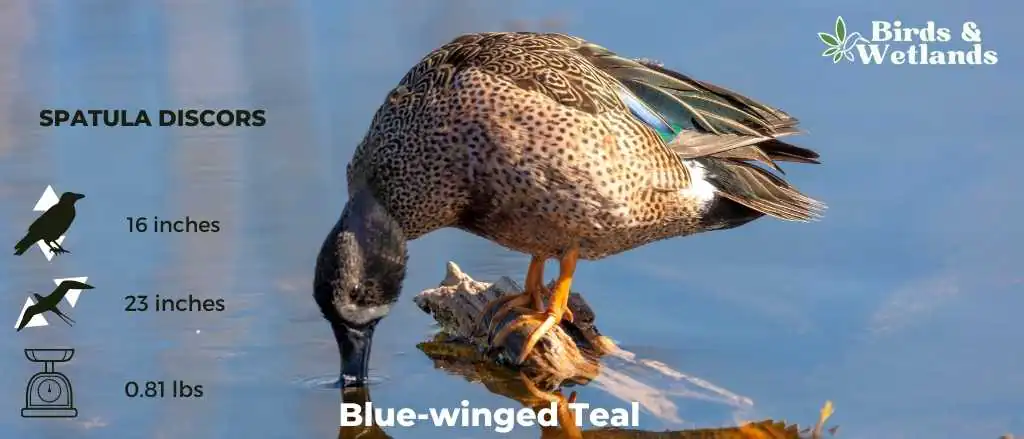The blue-winged teal is a member of the Anatidae family, including other ducks, geese and swans. It is one of the smallest dabbling ducks that breed and occur in North America.
Carl Linnaeus first described the species in the 12th edition of his Systema Naturae, published in 1766. It was introduced with the binomial name Anas discors. It has since moved to the genus Spatula with 10 other duck species.
Scientific Name: Spatula discors
Height: 40 cm (16 in)
Wingspan: 58 cm (23 in)
Weight: 370 g (13 oz)
Blue-Winged Teal Description
The breeding male blue-winged teal is a small duck with a buffy-colored body and black speckles. The head, neck and feathers are dark gray, while the bill is black with a broad white crescent between the dark brown eyes.
The breast, belly and flanks are reddish-brown and spotted, while the tail, rump and rectrices are black with white patches. The crown and throat are black, while the glossy purple feathers adorn the sides of its head. Its primary upper wing converts are blue-gray, while the secondares form a green speculum.
The female blue-winged teal is similar in size to the male but lacks the bright colors and white patch of her counterpart. The body is mottled brown with dark streaks, while the head and neck are buffy brown. It also has blue wings and yellow legs.
Its bill is black, with an inconspicuously small white ring around the base. The breast and sides are mottled with browns, grays, and whites.
In its winter plumage, the male blue-winged teal resembles the female.
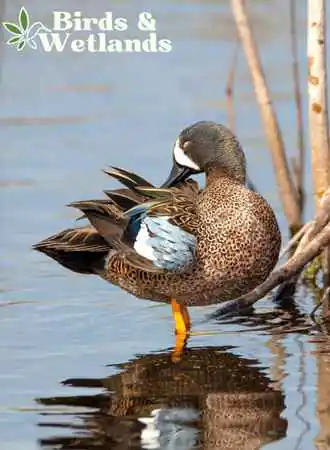
Listen to Blue-Winged Teal
For the most part, the blue-winged teal is silent. But it makes a variety of calls, depending on the situation.
During the breeding season, males make a “tsii-tsii” sound to attract mates. When flying or fleeing from danger, they emit a loud, high whistling sound.
Females and juveniles make a soft quack.
Blue-Winged Teal Habitat & Range
The blue-winged teal is found in North America, primarily in the northern and central United States and southern Canada. Its breeding range extends north of Alaska’s Arctic coast and south as the Gulf Coast of southern Texas and Louisiana in the summer months.
These small ducks breed in eastern Washington, along the Atlantic coast and in northern prairies of the United States and Canada.
Blue-winged teal prefers shallow wetlands such as lakes, shallow marshes and temporary ponds with plenty of vegetation, including sedges, rushes and cattails. They also inhabit coastal estuaries with freshwater tidal marshes and brackish bays. Its breeding habitat also includes open-country wetlands.
Additionally, the blue-winged teal is the most abundant duck in the grassland prairies of the Dakotas and prairie provinces of Canada.
Grasses, sedges, and hayfields provide nesting cover for these birds, while heavy growth of bulrushes and cattails provide escape cover. The species is also found in wetlands of boreal forest associations and deciduous woodlands.
In the winter months, blue-winged teal migrates to freshwater wetlands in the southern United States, Mexico, the Caribbean Islands and Central America, where they spend their days foraging for food. Some flocks travel long distances over open ocean to South America.
During the fall season, the blue-winged teal are among the first ducks south of its breeding range.
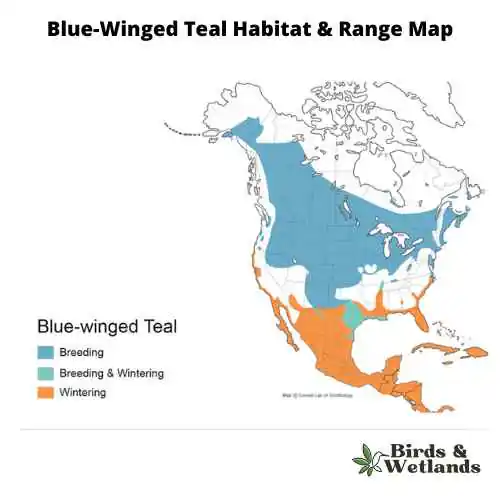
Blue-Winged Teal Diet & Food Habits
The blue-winged teal is a versatile and opportunistic feeder, consuming a variety of aquatic invertebrates, crustaceans, mollusks, seeds, aquatic plants and vegetation. They typically forage in very shallow water by dabbling or upending to extract food items from the mud or substrate.
In the winter months, when they migrate to southern latitudes in small groups, they switch to a diet of mostly seeds, which they glean from the surface of the water or pluck from the ground. They also consume some small fish and invertebrates.
Blue-Winged Teal Behavior
Blue-winged teal is strongly migratory. It often flies fast and agile in flocks of up to 40 birds, mixed with other dabbling ducks. While in flight, the distinctive blue speculum on the bird’s wings is displayed.
In its wintering sites, the blue-winged teal is often seen feeding in shallow ponds, flooded ditches, lakes, coastal areas and lagoons with other ducks, such as the cinnamon teal. Although mostly a dabbling duck, the blue-winged teal will occasionally dive and submerge its entire body underwater to forage food.
Blue-winged teals are active during the day and roost at night in tight formations on shallow wetlands or open waters. They prefer to be in groups but can also be seen alone or in pairs.
To escape predators, blue-winged teals will dive underwater and swim away quickly. They also use their wings to “flush” other waterfowl away from areas where they like to forage.
Blue-Winged Teal Nesting & Mating Habits
Courtship begins in late January to early February and breeding takes place in May to early June.
Blue-winged teal is seasonally monogamous, meaning pairs only remain with each other through the entire breeding season. Pairs may mate with the same or a different partner the next year.
Blue-winged teals form pairs on their wintering sites during spring migration. However, some females will choose their pair upon arriving on breeding grounds. They only breed once yearly.
The male will display in courtship by raising the wings and tail feathers while making quacking noises.
The female builds the nest in a shallow depression on dry ground. The nest is made from various grasses and lined with down feathers. It is typically located on the ground in emergent vegetation or a grassy meadow.
Ring-necked pheasants are known to dump their eggs into blue-winged teals’ nests.
The female typically lays 8-12 olive-white eggs and is solely responsible for incubating them for 23 to 24 days. The male leaves the female during the incubation period. The mother will watch over its young for the first few weeks.
Upon hatching, young birds can find their own food. Blue-winged teal ducklings fledge within 38 to 49 days and are often left alone by their mother even if they aren’t fully fledged. At that time, the young birds will join flocks of other species of ducks and head south for their wintering grounds during the cold months.
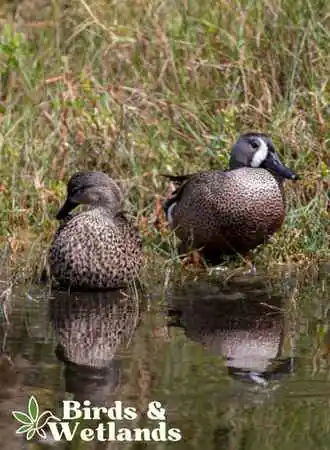
Blue-Winged Teal Predators
The blue-winged teal is preyed upon by several predators, including hawks, bald eagles, great-horned owls and other birds of prey.
In addition to avian predators, mammals such as foxes, coyotes, raccoons and skunks also hunt them. The duck is also vulnerable to fish such as northern pike, bass and walleye.
Blue-Winged Teal Population & Conservation Status
The population of the blue-winged teal is estimated to be between 3 and 5 million. This duck is considered abundant across its range, and recent surveys indicate stable populations. So its conservation status is “Least Concern”.
However, this species has experienced declines in some regions due to changes in wetlands habitat, drainage, and hunting pressure.
Conservation efforts include wetland protection, habitat restoration, research and monitoring of populations, and hunting restrictions. These measures are helping to ensure that the blue-winged teal population remains healthy.
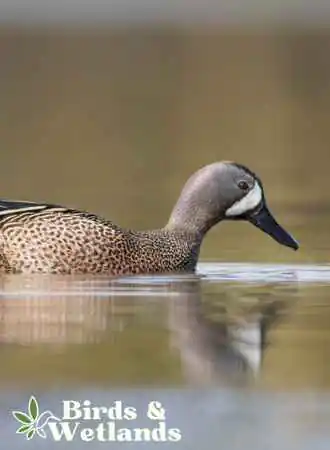
Blue-Winged Teal Hunting
The blue-winged teal is a popular game bird, and hunting regulations vary from state to state. Check with your local wildlife department for the most up-to-date regulations if you intend to hunt this duck.
Key Points
- Blue-winged teal eggs appear creamy white or olive white.
- Blue-winged teal populations are stable, and the species is currently listed as “Least Concern”.
- Like most ducks, blue-winged teal nests on the ground with dense vegetation, usually near the water’s edge.
- The female’s blue wing patch separates it from the female green-winged teal.
- This duck is a primary herbivore but may also occasionally eat animal matter.
- Some flocks winter in Central and South America.

